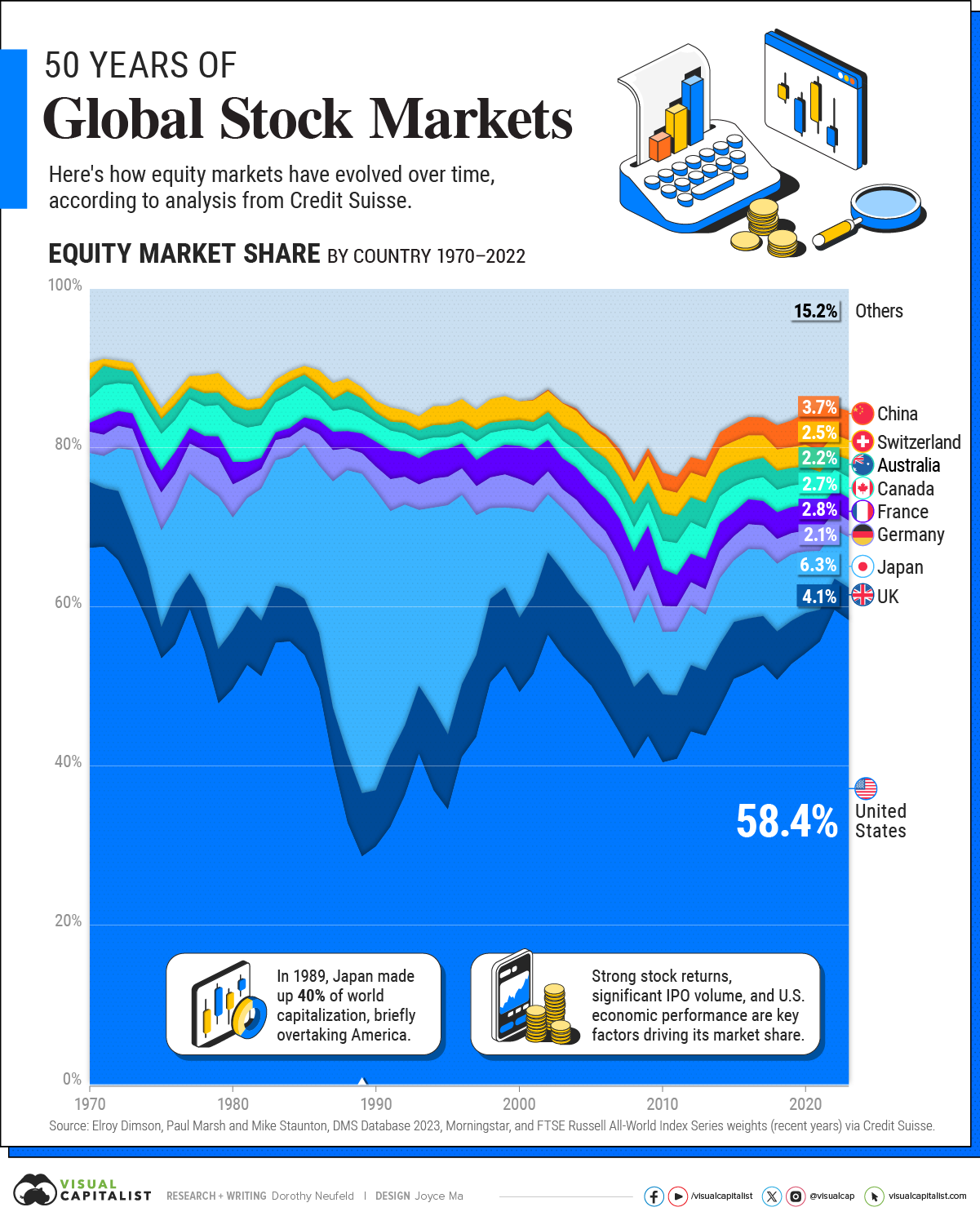Markets
Ranked: The Largest Stock Markets Over Time, by Country (1970-Today)
Subscribe to the Advisor Channel free mailing list for more like this

The Largest Stock Markets Over Time, by Country (1970-Today)
This was originally posted on Advisor Channel. Sign up to the free mailing list to get beautiful visualizations on financial markets that help advisors and their clients.
For decades, the U.S. has firmly remained the world’s financial power.
But how long will this continue, and what factors could underscore a new shift? To look at the role of the U.S. in the broader financial system, this graphic shows 50 years of global stock markets, with data from Credit Suisse.
Global Stock Markets Today
Today, the U.S. covers 58.4% of global equity markets as of year-end 2022.
| Top Stock Markets | Share of Global Stock Market 2022 |
|---|---|
| 🇺🇸 U.S. | 58.4% |
| 🇯🇵 Japan | 6.3% |
| 🇬🇧 U.K. | 4.1% |
| 🇨🇳 China | 3.7% |
| 🇫🇷 France | 2.8% |
| 🇨🇦 Canada | 2.7% |
| 🇨🇭 Switzerland | 2.5% |
| 🇦🇺 Australia | 2.2% |
| 🇩🇪 Germany | 2.1% |
| 🌎 Others | 15.2% |
The next largest stock market is Japan, at 6.3% of the global market share.
For a brief period in 1989, it overtook the U.S. when the Nikkei hit an all-time high following supercharged economic growth. However, after its subsequent crash and “lost decades”, it would take 33 years for Japan’s stock market to recover to those same highs.
Lastly, despite China being the world’s second-largest economy, it only accounts for just 3.7% of the world’s equity market share, a similar level as the UK.
Rise and Fall
Stock markets have been around for centuries.
While the New York Stock Exchange originated in 1792, Amsterdam’s stock market, arguably the world’s oldest, dates back to 1602.
During the mid-1700s, London began to overtake Amsterdam as a leading financial market amid growing financial activity and trade. An increasing number of firms set up offices in the city, bringing with them key business relationships.
After roughly 200 years, London’s role as a global financial center was surpassed by New York after WWII, driven by the economic crisis caused by the war.
America’s rise in prominence was supported by the growing credibility of the Federal Reserve, while the global status of the Bank of England diminished as the value of the pound weakened.
Given the destabilizing effects of the war, the U.S. filled the vacuum, emerging as a leading stock market supported by a robust economy and central bank—a position it continues to hold.
What Comes Next?
Why is America’s influence over global stock markets unrivaled?
The dollar’s status as a reserve currency plays a central role, along with the depth of its financial markets. Its economic, political, and military strength are other important factors.
America’s stock market returns have also outperformed nearly all other countries since 1900, attracting investors both domestically and abroad.
While American “declinism” has become a cliche, countries have risen and fallen over history. In the early 19th century, Britain’s publicly held debt soared from 109% of GDP in 1918 to roughly 200% by 1934. By around this time, its economic output had been exceeded by America, Germany, and the Soviet Union.
While there are key differences between the U.S. and Britain at that time, history suggests that balances in military power, debt, and economic dominance were key variables in the rise and decline of financial powers.
Markets
The European Stock Market: Attractive Valuations Offer Opportunities
On average, the European stock market has valuations that are nearly 50% lower than U.S. valuations. But how can you access the market?

European Stock Market: Attractive Valuations Offer Opportunities
Europe is known for some established brands, from L’Oréal to Louis Vuitton. However, the European stock market offers additional opportunities that may be lesser known.
The above infographic, sponsored by STOXX, outlines why investors may want to consider European stocks.
Attractive Valuations
Compared to most North American and Asian markets, European stocks offer lower or comparable valuations.
| Index | Price-to-Earnings Ratio | Price-to-Book Ratio |
|---|---|---|
| EURO STOXX 50 | 14.9 | 2.2 |
| STOXX Europe 600 | 14.4 | 2 |
| U.S. | 25.9 | 4.7 |
| Canada | 16.1 | 1.8 |
| Japan | 15.4 | 1.6 |
| Asia Pacific ex. China | 17.1 | 1.8 |
Data as of February 29, 2024. See graphic for full index names. Ratios based on trailing 12 month financials. The price to earnings ratio excludes companies with negative earnings.
On average, European valuations are nearly 50% lower than U.S. valuations, potentially offering an affordable entry point for investors.
Research also shows that lower price ratios have historically led to higher long-term returns.
Market Movements Not Closely Connected
Over the last decade, the European stock market had low-to-moderate correlation with North American and Asian equities.
The below chart shows correlations from February 2014 to February 2024. A value closer to zero indicates low correlation, while a value of one would indicate that two regions are moving in perfect unison.
| EURO STOXX 50 | STOXX EUROPE 600 | U.S. | Canada | Japan | Asia Pacific ex. China |
|
|---|---|---|---|---|---|---|
| EURO STOXX 50 | 1.00 | 0.97 | 0.55 | 0.67 | 0.24 | 0.43 |
| STOXX EUROPE 600 | 1.00 | 0.56 | 0.71 | 0.28 | 0.48 | |
| U.S. | 1.00 | 0.73 | 0.12 | 0.25 | ||
| Canada | 1.00 | 0.22 | 0.40 | |||
| Japan | 1.00 | 0.88 | ||||
| Asia Pacific ex. China | 1.00 |
Data is based on daily USD returns.
European equities had relatively independent market movements from North American and Asian markets. One contributing factor could be the differing sector weights in each market. For instance, technology makes up a quarter of the U.S. market, but health care and industrials dominate the broader European market.
Ultimately, European equities can enhance portfolio diversification and have the potential to mitigate risk for investors.
Tracking the Market
For investors interested in European equities, STOXX offers a variety of flagship indices:
| Index | Description | Market Cap |
|---|---|---|
| STOXX Europe 600 | Pan-regional, broad market | €10.5T |
| STOXX Developed Europe | Pan-regional, broad-market | €9.9T |
| STOXX Europe 600 ESG-X | Pan-regional, broad market, sustainability focus | €9.7T |
| STOXX Europe 50 | Pan-regional, blue-chip | €5.1T |
| EURO STOXX 50 | Eurozone, blue-chip | €3.5T |
Data is as of February 29, 2024. Market cap is free float, which represents the shares that are readily available for public trading on stock exchanges.
The EURO STOXX 50 tracks the Eurozone’s biggest and most traded companies. It also underlies one of the world’s largest ranges of ETFs and mutual funds. As of November 2023, there were €27.3 billion in ETFs and €23.5B in mutual fund assets under management tracking the index.
“For the past 25 years, the EURO STOXX 50 has served as an accurate, reliable and tradable representation of the Eurozone equity market.”
— Axel Lomholt, General Manager at STOXX
Partnering with STOXX to Track the European Stock Market
Are you interested in European equities? STOXX can be a valuable partner:
- Comprehensive, liquid and investable ecosystem
- European heritage, global reach
- Highly sophisticated customization capabilities
- Open architecture approach to using data
- Close partnerships with clients
- Part of ISS STOXX and Deutsche Börse Group
With a full suite of indices, STOXX can help you benchmark against the European stock market.

Learn how STOXX’s European indices offer liquid and effective market access.

-

 Economy4 days ago
Economy4 days agoEconomic Growth Forecasts for G7 and BRICS Countries in 2024
The IMF has released its economic growth forecasts for 2024. How do the G7 and BRICS countries compare?
-

 Markets2 weeks ago
Markets2 weeks agoU.S. Debt Interest Payments Reach $1 Trillion
U.S. debt interest payments have surged past the $1 trillion dollar mark, amid high interest rates and an ever-expanding debt burden.
-

 United States2 weeks ago
United States2 weeks agoRanked: The Largest U.S. Corporations by Number of Employees
We visualized the top U.S. companies by employees, revealing the massive scale of retailers like Walmart, Target, and Home Depot.
-

 Markets2 weeks ago
Markets2 weeks agoThe Top 10 States by Real GDP Growth in 2023
This graphic shows the states with the highest real GDP growth rate in 2023, largely propelled by the oil and gas boom.
-

 Markets3 weeks ago
Markets3 weeks agoRanked: The World’s Top Flight Routes, by Revenue
In this graphic, we show the highest earning flight routes globally as air travel continued to rebound in 2023.
-

 Markets3 weeks ago
Markets3 weeks agoRanked: The Most Valuable Housing Markets in America
The U.S. residential real estate market is worth a staggering $47.5 trillion. Here are the most valuable housing markets in the country.
-

 Science1 week ago
Science1 week agoVisualizing the Average Lifespans of Mammals
-

 Demographics2 weeks ago
Demographics2 weeks agoThe Smallest Gender Wage Gaps in OECD Countries
-

 United States2 weeks ago
United States2 weeks agoWhere U.S. Inflation Hit the Hardest in March 2024
-

 Green2 weeks ago
Green2 weeks agoTop Countries By Forest Growth Since 2001
-

 United States2 weeks ago
United States2 weeks agoRanked: The Largest U.S. Corporations by Number of Employees
-

 Maps2 weeks ago
Maps2 weeks agoThe Largest Earthquakes in the New York Area (1970-2024)
-

 Green2 weeks ago
Green2 weeks agoRanked: The Countries With the Most Air Pollution in 2023
-

 Green2 weeks ago
Green2 weeks agoRanking the Top 15 Countries by Carbon Tax Revenue








